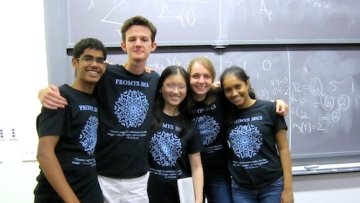14:30
14:30
14:30
Points in almost general position
Abstract
Erdős asked the following question: given a positive integer $n$, what is the largest integer $k$ such that any set of $n$ points in a plane, with no $4$ on a line, contains $k$ points no $3$ of which are collinear? Füredi proved that $k = o(n)$. Cardinal, Toth and Wood extended this result to $\mathbb{R}^3$, finding sets of $n$ points with no $5$ on a plane whose subsets with no $4$ points on a plane have size $o(n)$, and asked the question for the higher dimensions. For given $n$, let $k$ be largest integer such that any set of $n$ points in $\mathbb{R}^d$ with no more than $d + 1$ cohyperplanar points, has $k$ points with no $d + 1$ on a hyperplane. Is $k = o(n)$? We prove that $k = o(n)$ for any fixed $d \geq 3$.
BRST Cohomology, Extraordinary Invariants and the Zen Splitting of SUSY
Abstract
The chiral scalar superfield has interesting BRST cohomology, but the relevant cohomology objects all have spinor indices. So they cannot occur in an action. They need to be coupled to a chiral dotted spinor superfield. Until now, this has been very problematic, since no sensible action for a chiral dotted spinor superfield was known. The most obvious such action contains higher derivatives and tachyons.
Now, a sensible action has been found. When coupled to the cohomology, this action removes the supersymmetry charge from the theory while maintaining the rigidity and power of supersymmetry.The simplest example of this phenomenon has exactly the fermion content of the Leptons or the Quarks. The mechanism has the potential to get around the cosmological constant problem, and also the problem of the sum rules of spontaneously broken supersymmetry.
Symmetry enhancement near horizons
Abstract
I shall demonstrate, under some mild assumptions, that the symmetry group of extreme, Killing, supergravity horzions contains an sl(2, R) subalgebra. The proof requires a generalization of the Lichnerowicz theorem for non-metric connections. The techniques developed can also be applied in the classification
of AdS and Minkowski flux backgrounds.
We are delighted to annouce that PROMYS Europe will take place in Oxford in July and August of this year. Building on the hugely successful PROMYS programmes in the USA, PROMYS Europe is a challenging programme designed to encourage mathematically ambitious secondary school students to explore the creative world of mathematics. PROMYS is about asking and answering challenging questions, hard work and experiencing the sheer pleasure and beauty of mathematics.
Model theory and the distribution of orders in number fields
Abstract
Algebraic-geometric aspects of constructing G2 manifolds as connected sums
Abstract
I will speak about weak Fano 3-folds, K3 surfaces and their Picard lattices, and explain how to solve the matching problem in various situations.
Choking of flow through a poroelastic material
Abstract
Flow thought a porous media is usually described by assuming the superficial velocity can be expressed in terms of a constant permeability and a pressure gradient. In poroelastic flows the underlying elastic matrix responds to changes in the fluid pressure. When the elastic deformation is allowed to influence the permeability through the elastic strain, it becomes possible for increased fluid pressure gradient not to result in increased flow, but to decrease the permeability and potentially this may close off or choke the flow. I will talk about a simple model problem for a number of different elastic constitutive models and a number of different permeability-strain models and examine whether there is a general criterion that can be derived to show when, or indeed if, choking can occur for different elasticity-permeability combinations.
Expander parallel $\ell_0$ decoding
Abstract
We present an algorithm, Parallel-$\ell_0$, for {\em combinatorial compressed sensing} (CCS), where the sensing matrix $A \in \mathbb{R}^{m\times n}$ is the adjacency matrix of an expander graph. The information preserving nature of expander graphs allow the proposed algorithm to provably recover a $k$-sparse vector $x\in\mathbb{R}^n$ from $m = \mathcal{O}(k \log (n/k))$ measurements $y = Ax$ via $\mathcal{O}(\log k)$ simple and parallelizable iterations when the non-zeros in the support of the signal form a dissociated set, meaning that all of the $2^k$ subset sums of the support of $x$ are pairwise different. In addition to the low computational cost, Parallel-$\ell_0$ is observed to be able to recover vectors with $k$ substantially larger than previous CCS algorithms, and even higher than $\ell_1$-regularization when the number of measurements is significantly smaller than the vector length.


